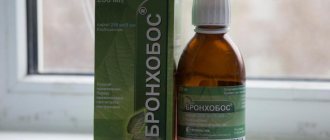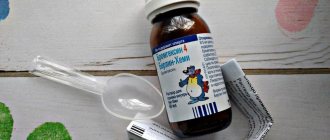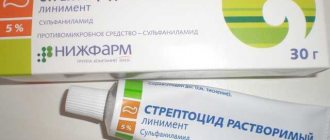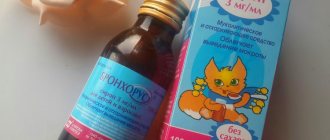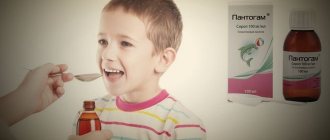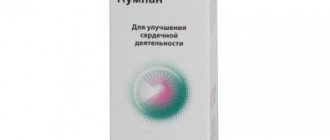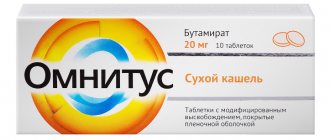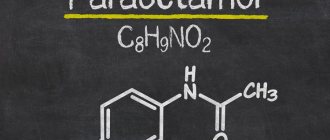Every person from time to time faces a problem such as cough. This symptom is accompanied by a huge number of diseases, including respiratory infections. And often in such cases, the doctor recommends that the patient take the drug Cofasma. The syrup helps cope with annoying coughing attacks.
Of course, before starting therapy it is worth looking for information about the drug. What components does Cofasma cough syrup consist of? What results can be achieved with the help of the medicine? Is it possible that any complications may occur during therapy? How much does a bottle of syrup cost? Many people are interested in the answers to these questions.
Release form and composition
The drug is produced in the form of a syrup: an orange liquid with a pineapple smell (100 or 200 ml in a dark plastic bottle with a screw-on aluminum cap, 1 bottle in a cardboard box complete with a dosing cap and instructions for using Cofasma).
1 ml of syrup contains:
- active ingredients: guaifenesin – 10 mg, bromhexine hydrochloride – 0.4 mg, salbutamol (in the form of sulfate) – 0.2 mg;
- additional components: sodium benzoate, propylene glycol, levomenthol, aspartame, sodium citrate dihydrate, citric acid, hypromellose, pineapple flavor, sunset yellow dye, purified water.
Rules of application
Cofasma syrup is used orally. The dose per 1 dose is calculated depending on the age of the patient who has the pathology. The frequency of administration is 3 times a day.
Dosages for the treatment of children:
| Age | Amount of drug |
| Up to 6 years | 5 ml per dose |
| 6-12 years | 5-10 ml at a time |
The dosage for children over 12 years of age, as well as adults, is 10 ml of syrup at a time.
Pharmacological properties
Pharmacodynamics
Cofasma is a combination drug with expectorant, bronchodilator and mucolytic effects. The effect of the drug is due to the properties of its active components:
- guaifenesin is a mucolytic agent that reduces the surface tension of the structures of the bronchopulmonary apparatus; activating the secretory cells of the bronchial mucosa, promotes the production of neutral polysaccharides, ensures the depolymerization of acidic mucopolysaccharides, thins sputum, stimulates the ciliary activity of the bronchi, facilitates and accelerates the transition of an unproductive cough to a productive one, improves the evacuation of sputum;
- Bromhexine is a mucolytic agent that exhibits an expectorant effect; promotes an increase in the serous component of bronchial secretions; activating the work of the cilia of the ciliated epithelium, increases the volume of sputum, reduces its viscosity and improves the process of discharge;
- salbutamol is a bronchodilator that stimulates β2-adrenergic receptors of blood vessels, bronchi and myometrium; prevents or relieves bronchospasm, reduces resistance in the respiratory tract, provides an increase in vital capacity of the lungs (VC); leads to dilation of the coronary arteries without reducing blood pressure (BP).
Pharmacokinetics
Guaifenesin is rapidly absorbed from the gastrointestinal tract (GIT) - 25-30 minutes after oral administration. Penetrates well into tissues that contain acidic mucopolysaccharides. About 60% of the administered dose of the active substance is metabolized in the liver, the half-life (T½) is 1 hour. Guaifenesin is excreted by the lungs with sputum and the kidneys with urine unchanged and in the form of inactive metabolites.
Bromhexine after oral administration for 30 minutes is almost completely (99%) absorbed into the gastrointestinal tract. The drug has low bioavailability due to the effect of the first passage through the liver, and is able to penetrate the blood-brain barrier (BBB) and the placental barrier. The process of metabolic transformation occurs in the liver through oxidation and demethylation, the substance is converted into the pharmacologically active metabolite ambroxol. As a result of slow reverse tissue diffusion, the T½ of the drug is about 15 hours; against the background of chronic renal failure, the elimination of its metabolites is impaired. Bromhexine is excreted by the kidneys and can accumulate with repeated use.
Salbutamol after oral administration is characterized by high absorption, bioavailability is approximately 50%. Concomitant use with food reduces the rate of absorption, but does not affect bioavailability. The substance binds to plasma proteins by 10% and can pass through the placental barrier. It is subjected to first-pass metabolism in the intestinal wall and liver, inactivated with the participation of phenolsulfotransferase to 4-o-sulfate ester, T½ - 3.8-6 hours. The drug is excreted in the urine (69–90%), mainly in the form of an inactive phenol sulfate metabolite (60%) over 72 hours and in bile (4%).
Overdose
There is no data on an overdose of Cofasma. The side effects of the medication may increase. In this case, therapy is symptomatic.
Cofasma (syrup for children) in case of overdose due to the effects of salbutamol can cause:
- dilatation of peripheral vessels;
- hypokalemia;
- ventricular flutter;
- tachyarrhythmia;
- the occurrence of seizures;
- the appearance of hallucinations;
- headache;
- development of hypoxemia;
- increased blood glucose;
- psychomotor agitation;
- development of respiratory alkalosis;
- lowering blood pressure;
- vomiting;
- feeling of nausea;
- the appearance of muscle tremors;
- rapid heartbeat (tachycardia).
If an excessive dose of salbutamol is taken, the most effective antidotes are cardioselective beta-adrenergic receptor antagonists. But to avoid bronchospasm, beta-blockers are used with precautions.
When using high dosages of salbutamol, hypokalemia is possible. In this regard, if there is a suspicion that there is an overdose, it is necessary to monitor the level of potassium in the blood.
If you take too large a dose of bromhexine, you may experience:
- nausea;
- vomit;
- diarrhea and other gastrointestinal disorders.
Therapy for bromhexine overdose: there is no specific antidote. If an excessive dose of the drug is taken, vomiting should be induced, after which the patient should be given liquid (water, milk). It is necessary to perform gastric lavage for 1-2 hours after taking an excessive dose.
Contraindications
Absolute:
- tachycardia, tachyarrhythmia;
- heart defects (including aortic stenosis);
- myocarditis;
- liver and/or kidney failure;
- thyrotoxicosis;
- decompensated diabetes mellitus;
- gastric bleeding, period of exacerbation of peptic ulcer of the stomach and duodenum;
- phenylketonuria;
- pregnancy and lactation;
- glaucoma;
- hypersensitivity to any component of the drug.
Relative (take Cofasma syrup with caution):
- arterial hypertension;
- severe damage to the cardiovascular system;
- peptic ulcer of the stomach and duodenum in remission;
- diabetes;
- hyperthyroidism.
The drug should not be combined with β-blockers.
Compatibility with other drugs
Xanthines, for example, such as theophylline, when used in combination with Cofasma, increase the risk of developing tachyarrhythmia.
Monoamine oxidase inhibitors (MAO) and TCAs (tricyclic antidepressants) enhance the effect of salbutamol and can cause a sudden decrease in blood pressure.
Cofasma (syrup for children), when combined with inhaled m-anticholinergic blockers, can increase intraocular pressure.
The drug cannot be combined with non-selective beta-adrenergic receptor antagonists. Glucocorticosteroids and diuretics lead to increased hypokalemia from salbutamol. Combined use with codeine-containing drugs and other cough suppressants slows down the separation of sputum from the bronchi.
Under the influence of bromhexine, sulfonamide drugs and drugs from the antibiotic group penetrate more quickly into the bronchial mucus in the first 4-5 days of treatment with them. Simultaneous treatment with bromhexine and a number of NSAIDs (for example, butadione, salicylates, phenylbutazone) may cause stomach irritation.
Side effects
- cardiovascular system: decreased blood pressure, tachycardia, peripheral vasodilation, collapse;
- nervous system: muscle cramps, hand tremors; when treated with high doses – dizziness, drowsiness, headache, sleep disturbance, increased nervous excitability;
- urinary system: urine stained pink;
- digestive tract: vomiting, nausea, diarrhea, increased activity of liver transaminases, exacerbation of gastric ulcer and duodenal ulcer;
- allergic reactions: urticaria, skin rash, paradoxical bronchospasm.
Analogs
Cofasma syrup has a number of analogues, such as:
Joset
It is a bronchodilator. This drug acts as a mucolytic and also has an expectorant effect. Produced in the form of medicinal syrup.
Joset comes with a special measuring cup. The bottle containing the syrup with the medicine is packed in a cardboard pack. 10 ml of Joset medicinal syrup contains: 1 mg of salbutamol (beta2-adrenergic agonist), 50 mg of guaifenesin, as well as 2 mg of bromhexine and menthol in an amount of 0.5 mg.
The drug is used orally. Dosing regimen of Joset: children under 6 years old are given Joset in a dosage of 5 ml 3 times a day, Joset syrup for children from 6 to 12 years old is prescribed 5-10 ml 3 times a day. For children over 12 years of age and adult patients, the recommended dosage is 10 ml 3 times a day. Price – 142-261 rub.
Ascoril
The drug is produced in tablet form (tablets of 10 pieces are placed in a cell package, which in turn is placed in a cardboard pack, the pack contains 1, 2 or 5 pieces). 1 tablet contains: bromhexine, as well as guaifenesin and salbutamol.
Ascoril is used orally. Doctors advise children over 12 years of age to use 1 piece. 3 r/day, for children 6-12 years old - 1/2 or 1 tablet 3 r/day. The price for Ascoril varies from 177 to 342 rubles.
Cashnol
Produced in the form of syrup. The cardboard pack contains a measuring cup for dosing Kashnol. The syrup contains: menthol, salbutamol, as well as bromhexine and guaifenesin.
Cashnol is used internally. Recommended dosage for patients 3 times a day: children aged 3-6 years - 5 ml, children 6-12 years old should be given 5-10 ml of Kashnol. For adult patients, as well as children over 12 years of age, the dosage of Cashnol is 10 ml. An interval of at least 6 hours must be maintained between doses of the drug. The cost is 116-148 rubles.
Bronchostop
It is transparent, colorless or slightly yellowish in color, with the aroma of vanillin (a cardboard pack contains 1 bottle of 100 ml, a spoon and a measuring cup). 5 ml contains 4 mg of bromhexine.
The medicine is used orally, regardless of food intake. Doctors advise taking Bronchostop in the following dosages: 3 times a day: children under 2 years old - 2 mg; 2-6 years – 2-4 mg of syrup; from 6 to 14 years – 4-8 mg. For adult patients and children over 14 years of age, the dosage is 8–16 mg 3–4 times a day. The cost is approximately 500 rubles.
The drug Cofasma, when taken after a doctor's prescription, can eliminate cough and facilitate easier removal of phlegm. This syrup for children is one of the most effective for cough therapy.
Drug interactions
- β-adrenergic agonists, xanthines (including theophylline): the risk of tachyarrhythmias increases;
- monoamine oxidase inhibitors (MAOIs), tricyclic antidepressants: the effect of salbutamol is enhanced, which can provoke a sharp decrease in blood pressure (this combination is not recommended);
- non-selective β-blockers: incompatible with taking Cofasma;
- glucocorticosteroids, diuretics: the hypokalemic effect of salbutamol increases;
- antitussives, including drugs containing codeine: it makes it difficult to clear sputum (Cophasma should not be used in combination with these drugs);
- cephalexin, erythromycin, oxytetracycline: the penetration of these antibiotics into the lung tissue is improved thanks to the bromhexine included in the drug.
Precautionary measures
Caution must be exercised when:
- ulcerative pathology of the duodenum, stomach;
- arterial hypertension;
- carbohydrate metabolism disorders;
- simultaneous use of monoamine oxidase inhibitors (MAOIs), cough medications, non-selective adrenergic blockers (for example, propranolol).
The drug leads to potentiation of the action of central nervous system stimulants. Xanthines (for example, theophylline), when taken together with Cofasma, increase the risk of tachyarrhythmias; levodopa, drugs from the group of inhalational anesthetics, anesthesia method - severe ventricular arrhythmias.
When combined with m-cholinergic receptor blockers, it can lead to an increase in intraocular pressure. When combined with glucocorticosteroids and diuretics, the possibility of developing hypokalemia increases.
Lyell's and Stevens-Johnson syndromes have rarely occurred due to bromhexine, which is contained in this medicine. If changes appear on the skin or mucous membranes, you should immediately stop using the medicine and seek medical help from a specialist.
Cofasma syrup
When treating with this medicine, doctors advise consuming enough fluids - this helps maintain the effect of bromhexine in reducing the viscosity of sputum. When treating children, it is necessary to simultaneously perform vibration massage or postural chest drainage, which helps facilitate the removal of bronchial mucus.
Bromhexine is able to pass into breast milk and through the placental barrier. The medicine cannot be used during pregnancy and lactation.
If treatment with this medicine is necessary during lactation, then stop breastfeeding for this time interval. Guaifenesin causes urine to turn pink. Doctors do not recommend drinking alkaline drinks while taking the drug.
Due to the possible appearance of drowsiness, the development of dizziness and other undesirable effects, doctors advise, when treating with this drug, to refrain from driving various mechanisms and vehicles and from other activities that are potentially dangerous and which require a high concentration of attention and speed of mental and motor reactions .
Reviews about Cophasma
According to many reviews of Cophasma, the drug effectively helps children and adults cope with cough. Patients note that after several days of treatment with an expectorant, the viscosity of sputum decreases, its discharge improves, and coughing attacks become less intense. They also indicate that the cost of the syrup is approximately two times lower than the cost of its known analogues.
At the same time, there are reviews in which patients express dissatisfaction with the effect of Cophasma, considering it very weak. It is noted that treatment with the drug shows good results only with a mild cough and is completely ineffective with a severe form. In many reviews, the disadvantages of the syrup include its unpleasant taste. There are no complaints about the development of adverse reactions.
Who is it shown to?
Cofasma (syrup for children) is used in the treatment of pathologies of the lungs and bronchi, in which there are difficulties with the discharge of viscous sputum from them, these are:
- tuberculosis;
- pneumoconiosis;
- chronic obstructive pulmonary pathologies;
- pneumonia;
- tracheobronchitis.
In the treatment of children, when using cough syrups, it is much easier to solve the problem of a child’s negative emotional reaction to a medication or even refusal of the medication. Most syrups taste good and also have a pleasant aroma.
Additionally, the use of syrups is recommended for those who have difficulty using tablet medications, for example, with dysphagia, in which taking tablets provokes a pronounced gag reflex, or if the patient has a pronounced weakening.
